Financial Analysis of Telstra Corporation: Cash Flow, Other Comprehensive Income, and Income Tax
VerifiedAdded on 2024/05/30
|12
|2690
|471
AI Summary
This report provides a comprehensive analysis of Telstra Corporation's financial statements for the years 2015, 2016, and 2017. The analysis focuses on three key areas: cash flow statements, other comprehensive income, and income tax. The report examines the trends in cash flow from operating, investing, and financing activities, analyzes the components of other comprehensive income, and investigates the calculation and reconciliation of corporate income tax. The report concludes with a discussion of the implications of the findings for Telstra's financial performance and future prospects.
Contribute Materials
Your contribution can guide someone’s learning journey. Share your
documents today.
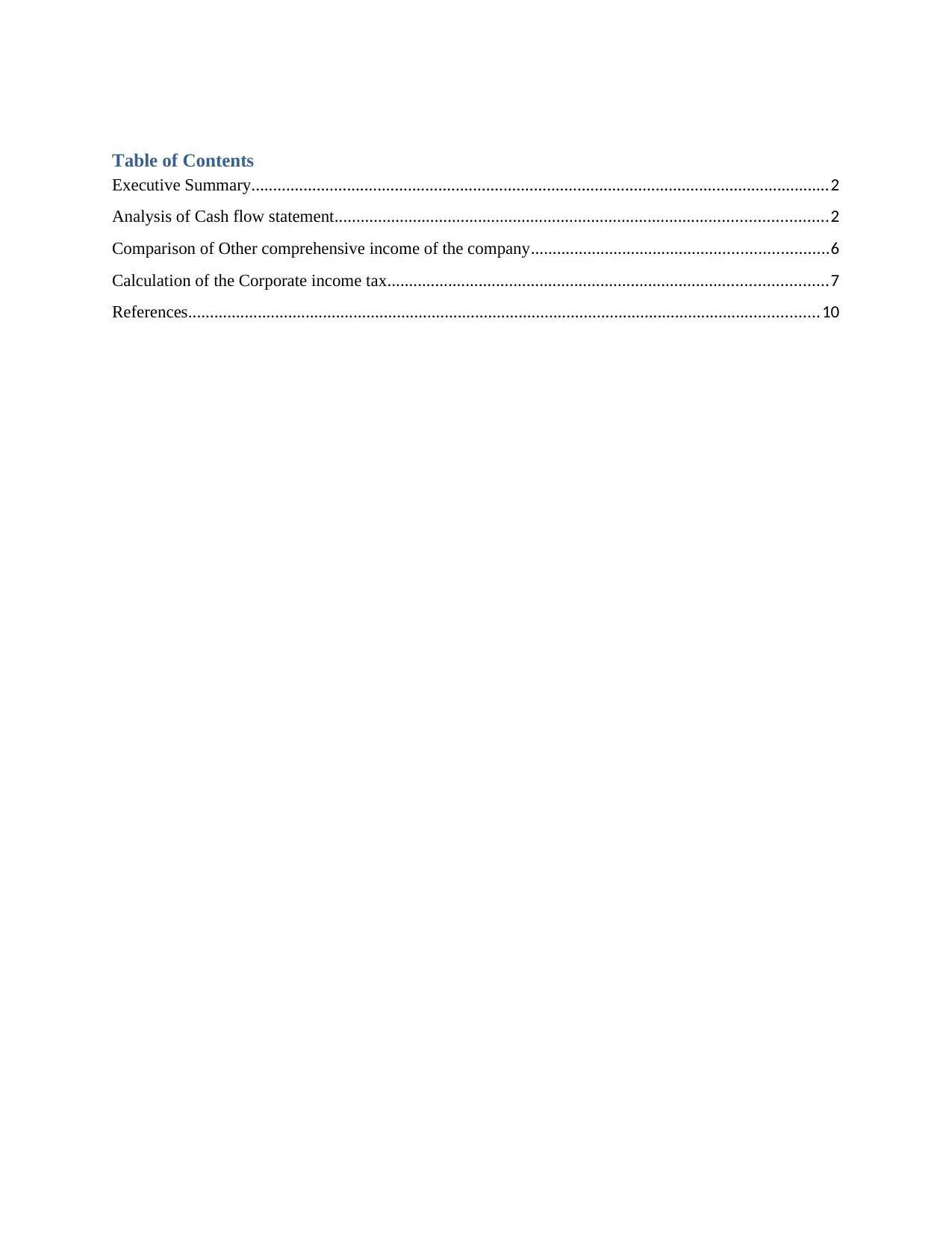
Table of Contents
Executive Summary.....................................................................................................................................2
Analysis of Cash flow statement.................................................................................................................2
Comparison of Other comprehensive income of the company....................................................................6
Calculation of the Corporate income tax.....................................................................................................7
References.................................................................................................................................................10
Executive Summary.....................................................................................................................................2
Analysis of Cash flow statement.................................................................................................................2
Comparison of Other comprehensive income of the company....................................................................6
Calculation of the Corporate income tax.....................................................................................................7
References.................................................................................................................................................10
Secure Best Marks with AI Grader
Need help grading? Try our AI Grader for instant feedback on your assignments.
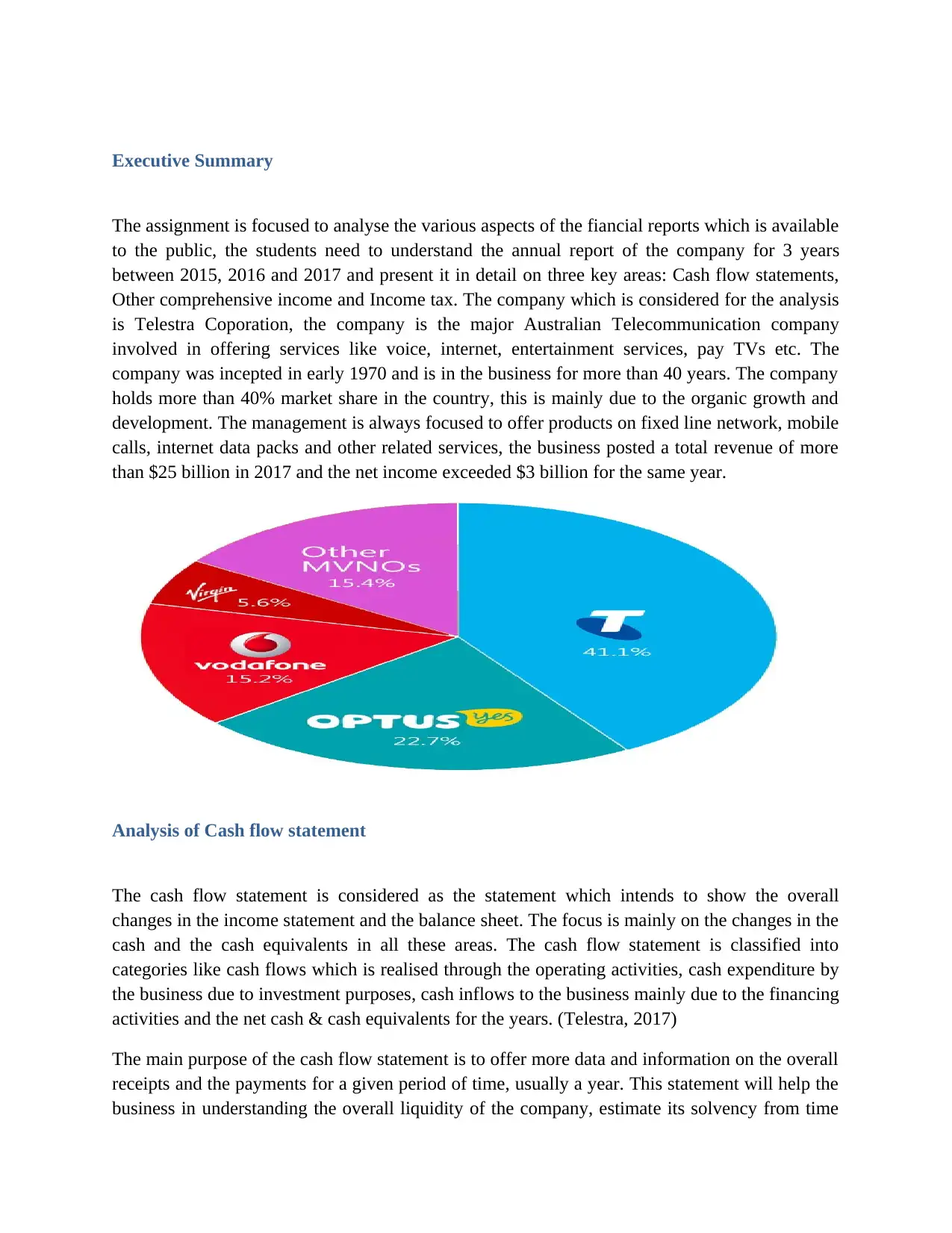
Executive Summary
The assignment is focused to analyse the various aspects of the fiancial reports which is available
to the public, the students need to understand the annual report of the company for 3 years
between 2015, 2016 and 2017 and present it in detail on three key areas: Cash flow statements,
Other comprehensive income and Income tax. The company which is considered for the analysis
is Telestra Coporation, the company is the major Australian Telecommunication company
involved in offering services like voice, internet, entertainment services, pay TVs etc. The
company was incepted in early 1970 and is in the business for more than 40 years. The company
holds more than 40% market share in the country, this is mainly due to the organic growth and
development. The management is always focused to offer products on fixed line network, mobile
calls, internet data packs and other related services, the business posted a total revenue of more
than $25 billion in 2017 and the net income exceeded $3 billion for the same year.
Analysis of Cash flow statement
The cash flow statement is considered as the statement which intends to show the overall
changes in the income statement and the balance sheet. The focus is mainly on the changes in the
cash and the cash equivalents in all these areas. The cash flow statement is classified into
categories like cash flows which is realised through the operating activities, cash expenditure by
the business due to investment purposes, cash inflows to the business mainly due to the financing
activities and the net cash & cash equivalents for the years. (Telestra, 2017)
The main purpose of the cash flow statement is to offer more data and information on the overall
receipts and the payments for a given period of time, usually a year. This statement will help the
business in understanding the overall liquidity of the company, estimate its solvency from time
The assignment is focused to analyse the various aspects of the fiancial reports which is available
to the public, the students need to understand the annual report of the company for 3 years
between 2015, 2016 and 2017 and present it in detail on three key areas: Cash flow statements,
Other comprehensive income and Income tax. The company which is considered for the analysis
is Telestra Coporation, the company is the major Australian Telecommunication company
involved in offering services like voice, internet, entertainment services, pay TVs etc. The
company was incepted in early 1970 and is in the business for more than 40 years. The company
holds more than 40% market share in the country, this is mainly due to the organic growth and
development. The management is always focused to offer products on fixed line network, mobile
calls, internet data packs and other related services, the business posted a total revenue of more
than $25 billion in 2017 and the net income exceeded $3 billion for the same year.
Analysis of Cash flow statement
The cash flow statement is considered as the statement which intends to show the overall
changes in the income statement and the balance sheet. The focus is mainly on the changes in the
cash and the cash equivalents in all these areas. The cash flow statement is classified into
categories like cash flows which is realised through the operating activities, cash expenditure by
the business due to investment purposes, cash inflows to the business mainly due to the financing
activities and the net cash & cash equivalents for the years. (Telestra, 2017)
The main purpose of the cash flow statement is to offer more data and information on the overall
receipts and the payments for a given period of time, usually a year. This statement will help the
business in understanding the overall liquidity of the company, estimate its solvency from time
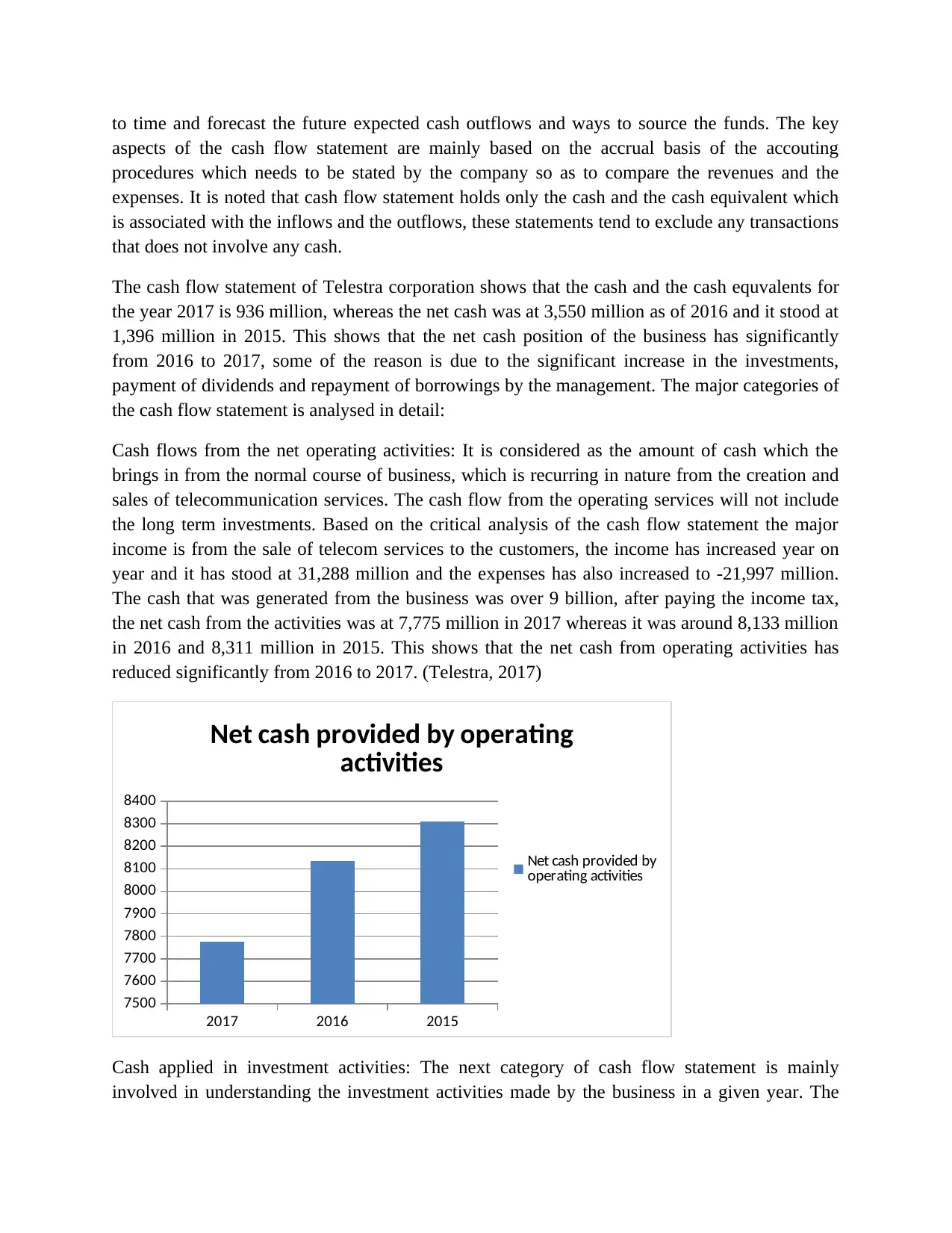
to time and forecast the future expected cash outflows and ways to source the funds. The key
aspects of the cash flow statement are mainly based on the accrual basis of the accouting
procedures which needs to be stated by the company so as to compare the revenues and the
expenses. It is noted that cash flow statement holds only the cash and the cash equivalent which
is associated with the inflows and the outflows, these statements tend to exclude any transactions
that does not involve any cash.
The cash flow statement of Telestra corporation shows that the cash and the cash equvalents for
the year 2017 is 936 million, whereas the net cash was at 3,550 million as of 2016 and it stood at
1,396 million in 2015. This shows that the net cash position of the business has significantly
from 2016 to 2017, some of the reason is due to the significant increase in the investments,
payment of dividends and repayment of borrowings by the management. The major categories of
the cash flow statement is analysed in detail:
Cash flows from the net operating activities: It is considered as the amount of cash which the
brings in from the normal course of business, which is recurring in nature from the creation and
sales of telecommunication services. The cash flow from the operating services will not include
the long term investments. Based on the critical analysis of the cash flow statement the major
income is from the sale of telecom services to the customers, the income has increased year on
year and it has stood at 31,288 million and the expenses has also increased to -21,997 million.
The cash that was generated from the business was over 9 billion, after paying the income tax,
the net cash from the activities was at 7,775 million in 2017 whereas it was around 8,133 million
in 2016 and 8,311 million in 2015. This shows that the net cash from operating activities has
reduced significantly from 2016 to 2017. (Telestra, 2017)
2017 2016 2015
7500
7600
7700
7800
7900
8000
8100
8200
8300
8400
Net cash provided by operating
activities
Net cash provided by
operating activities
Cash applied in investment activities: The next category of cash flow statement is mainly
involved in understanding the investment activities made by the business in a given year. The
aspects of the cash flow statement are mainly based on the accrual basis of the accouting
procedures which needs to be stated by the company so as to compare the revenues and the
expenses. It is noted that cash flow statement holds only the cash and the cash equivalent which
is associated with the inflows and the outflows, these statements tend to exclude any transactions
that does not involve any cash.
The cash flow statement of Telestra corporation shows that the cash and the cash equvalents for
the year 2017 is 936 million, whereas the net cash was at 3,550 million as of 2016 and it stood at
1,396 million in 2015. This shows that the net cash position of the business has significantly
from 2016 to 2017, some of the reason is due to the significant increase in the investments,
payment of dividends and repayment of borrowings by the management. The major categories of
the cash flow statement is analysed in detail:
Cash flows from the net operating activities: It is considered as the amount of cash which the
brings in from the normal course of business, which is recurring in nature from the creation and
sales of telecommunication services. The cash flow from the operating services will not include
the long term investments. Based on the critical analysis of the cash flow statement the major
income is from the sale of telecom services to the customers, the income has increased year on
year and it has stood at 31,288 million and the expenses has also increased to -21,997 million.
The cash that was generated from the business was over 9 billion, after paying the income tax,
the net cash from the activities was at 7,775 million in 2017 whereas it was around 8,133 million
in 2016 and 8,311 million in 2015. This shows that the net cash from operating activities has
reduced significantly from 2016 to 2017. (Telestra, 2017)
2017 2016 2015
7500
7600
7700
7800
7900
8000
8100
8200
8300
8400
Net cash provided by operating
activities
Net cash provided by
operating activities
Cash applied in investment activities: The next category of cash flow statement is mainly
involved in understanding the investment activities made by the business in a given year. The
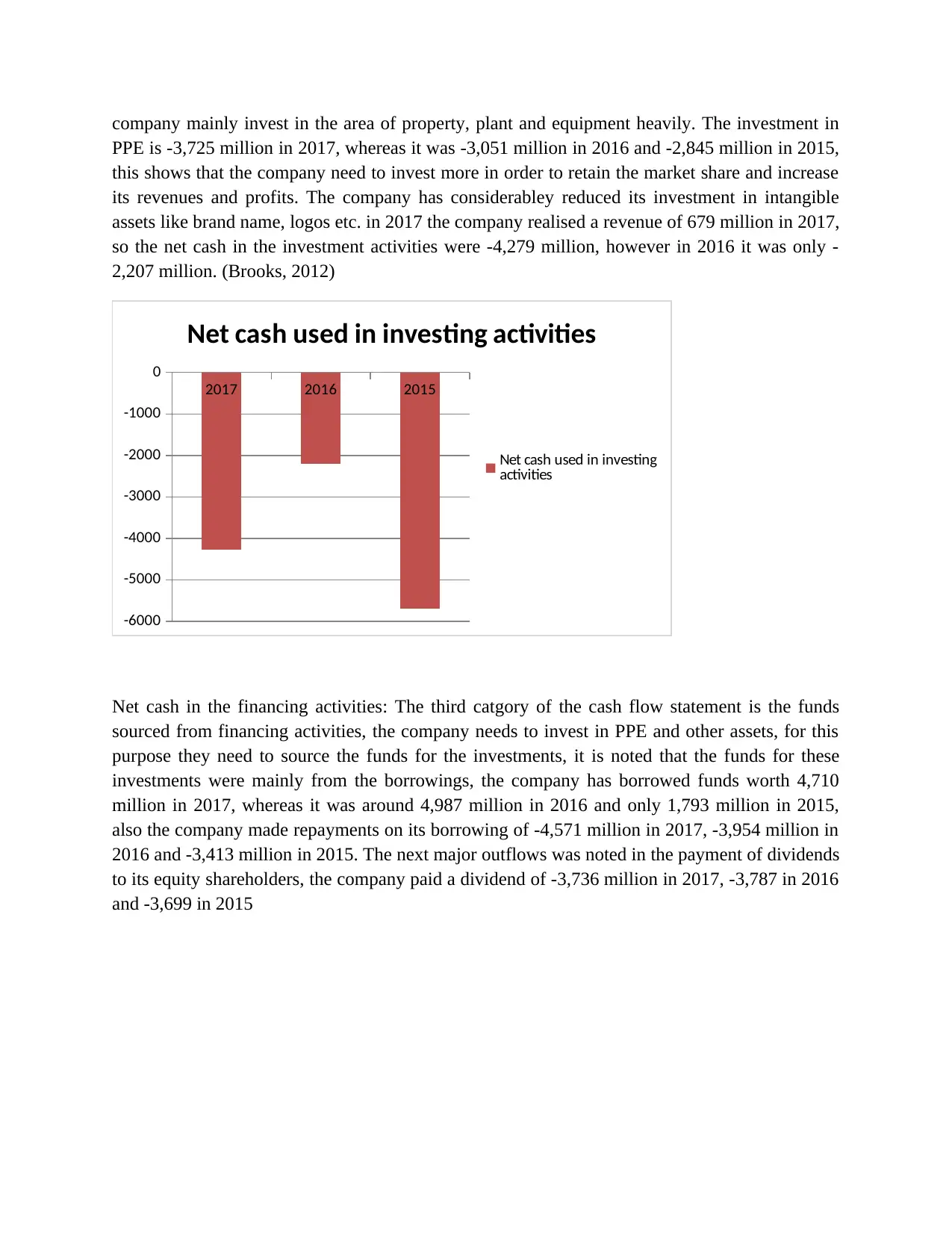
company mainly invest in the area of property, plant and equipment heavily. The investment in
PPE is -3,725 million in 2017, whereas it was -3,051 million in 2016 and -2,845 million in 2015,
this shows that the company need to invest more in order to retain the market share and increase
its revenues and profits. The company has considerabley reduced its investment in intangible
assets like brand name, logos etc. in 2017 the company realised a revenue of 679 million in 2017,
so the net cash in the investment activities were -4,279 million, however in 2016 it was only -
2,207 million. (Brooks, 2012)
2017 2016 2015
-6000
-5000
-4000
-3000
-2000
-1000
0
Net cash used in investing activities
Net cash used in investing
activities
Net cash in the financing activities: The third catgory of the cash flow statement is the funds
sourced from financing activities, the company needs to invest in PPE and other assets, for this
purpose they need to source the funds for the investments, it is noted that the funds for these
investments were mainly from the borrowings, the company has borrowed funds worth 4,710
million in 2017, whereas it was around 4,987 million in 2016 and only 1,793 million in 2015,
also the company made repayments on its borrowing of -4,571 million in 2017, -3,954 million in
2016 and -3,413 million in 2015. The next major outflows was noted in the payment of dividends
to its equity shareholders, the company paid a dividend of -3,736 million in 2017, -3,787 in 2016
and -3,699 in 2015
PPE is -3,725 million in 2017, whereas it was -3,051 million in 2016 and -2,845 million in 2015,
this shows that the company need to invest more in order to retain the market share and increase
its revenues and profits. The company has considerabley reduced its investment in intangible
assets like brand name, logos etc. in 2017 the company realised a revenue of 679 million in 2017,
so the net cash in the investment activities were -4,279 million, however in 2016 it was only -
2,207 million. (Brooks, 2012)
2017 2016 2015
-6000
-5000
-4000
-3000
-2000
-1000
0
Net cash used in investing activities
Net cash used in investing
activities
Net cash in the financing activities: The third catgory of the cash flow statement is the funds
sourced from financing activities, the company needs to invest in PPE and other assets, for this
purpose they need to source the funds for the investments, it is noted that the funds for these
investments were mainly from the borrowings, the company has borrowed funds worth 4,710
million in 2017, whereas it was around 4,987 million in 2016 and only 1,793 million in 2015,
also the company made repayments on its borrowing of -4,571 million in 2017, -3,954 million in
2016 and -3,413 million in 2015. The next major outflows was noted in the payment of dividends
to its equity shareholders, the company paid a dividend of -3,736 million in 2017, -3,787 in 2016
and -3,699 in 2015
Secure Best Marks with AI Grader
Need help grading? Try our AI Grader for instant feedback on your assignments.

2017 2016 2015
-8000
-7000
-6000
-5000
-4000
-3000
-2000
-1000
0
Net cash used in financing activities
Net cash used in financing
activities
Overall comparison of the cash flows
The folowing table shows the overall comparison of cash flow statement between 2015 to 2017.
Particulars 2017 2016 2015
Net cash provided by operating activities
7,775.0
0
8,133.0
0
8,311.0
0
Net cash used in investing activities
-
4,279.0
0
-
2,207.0
0
-
5,692.0
0
Net cash used in financing activities
-
6,104.0
0
-
3,777.0
0
-
6,882.0
0
Cash and cash equivalents at the end of the
year 936.00
3,550.0
0
1,396.0
0
-8000
-7000
-6000
-5000
-4000
-3000
-2000
-1000
0
Net cash used in financing activities
Net cash used in financing
activities
Overall comparison of the cash flows
The folowing table shows the overall comparison of cash flow statement between 2015 to 2017.
Particulars 2017 2016 2015
Net cash provided by operating activities
7,775.0
0
8,133.0
0
8,311.0
0
Net cash used in investing activities
-
4,279.0
0
-
2,207.0
0
-
5,692.0
0
Net cash used in financing activities
-
6,104.0
0
-
3,777.0
0
-
6,882.0
0
Cash and cash equivalents at the end of the
year 936.00
3,550.0
0
1,396.0
0
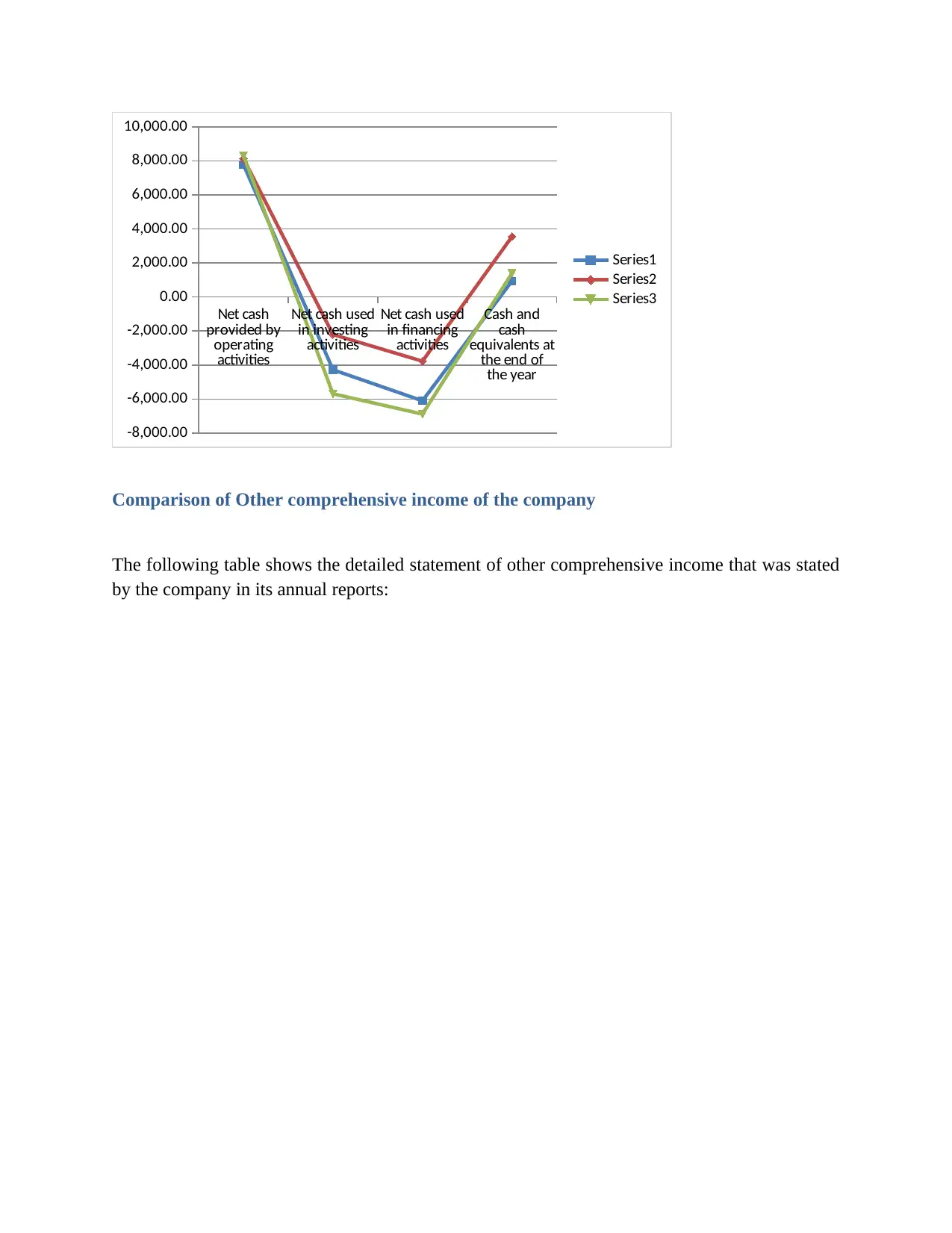
Net cash
provided by
operating
activities
Net cash used
in investing
activities
Net cash used
in financing
activities
Cash and
cash
equivalents at
the end of
the year
-8,000.00
-6,000.00
-4,000.00
-2,000.00
0.00
2,000.00
4,000.00
6,000.00
8,000.00
10,000.00
Series1
Series2
Series3
Comparison of Other comprehensive income of the company
The following table shows the detailed statement of other comprehensive income that was stated
by the company in its annual reports:
provided by
operating
activities
Net cash used
in investing
activities
Net cash used
in financing
activities
Cash and
cash
equivalents at
the end of
the year
-8,000.00
-6,000.00
-4,000.00
-2,000.00
0.00
2,000.00
4,000.00
6,000.00
8,000.00
10,000.00
Series1
Series2
Series3
Comparison of Other comprehensive income of the company
The following table shows the detailed statement of other comprehensive income that was stated
by the company in its annual reports:
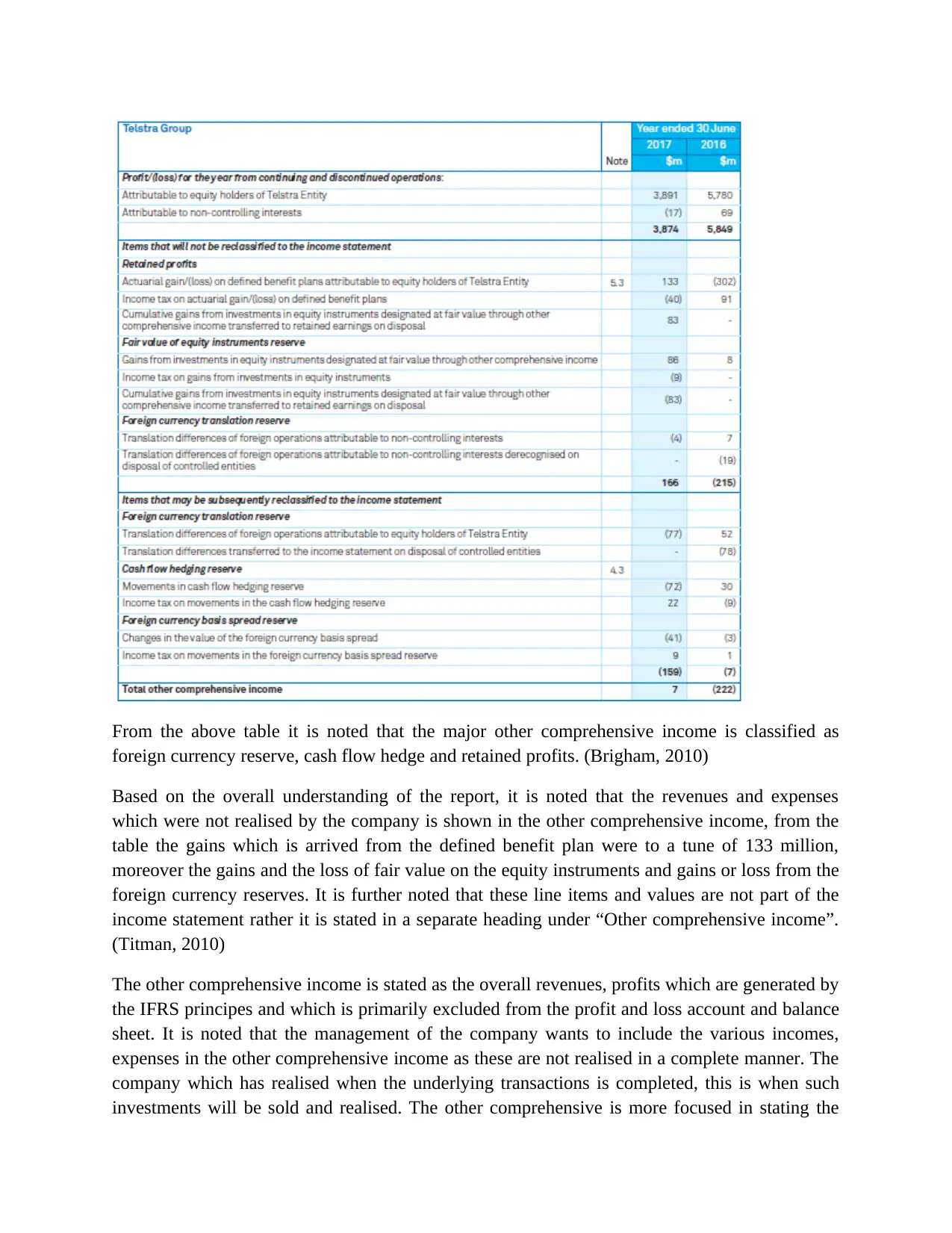
From the above table it is noted that the major other comprehensive income is classified as
foreign currency reserve, cash flow hedge and retained profits. (Brigham, 2010)
Based on the overall understanding of the report, it is noted that the revenues and expenses
which were not realised by the company is shown in the other comprehensive income, from the
table the gains which is arrived from the defined benefit plan were to a tune of 133 million,
moreover the gains and the loss of fair value on the equity instruments and gains or loss from the
foreign currency reserves. It is further noted that these line items and values are not part of the
income statement rather it is stated in a separate heading under “Other comprehensive income”.
(Titman, 2010)
The other comprehensive income is stated as the overall revenues, profits which are generated by
the IFRS principes and which is primarily excluded from the profit and loss account and balance
sheet. It is noted that the management of the company wants to include the various incomes,
expenses in the other comprehensive income as these are not realised in a complete manner. The
company which has realised when the underlying transactions is completed, this is when such
investments will be sold and realised. The other comprehensive is more focused in stating the
foreign currency reserve, cash flow hedge and retained profits. (Brigham, 2010)
Based on the overall understanding of the report, it is noted that the revenues and expenses
which were not realised by the company is shown in the other comprehensive income, from the
table the gains which is arrived from the defined benefit plan were to a tune of 133 million,
moreover the gains and the loss of fair value on the equity instruments and gains or loss from the
foreign currency reserves. It is further noted that these line items and values are not part of the
income statement rather it is stated in a separate heading under “Other comprehensive income”.
(Titman, 2010)
The other comprehensive income is stated as the overall revenues, profits which are generated by
the IFRS principes and which is primarily excluded from the profit and loss account and balance
sheet. It is noted that the management of the company wants to include the various incomes,
expenses in the other comprehensive income as these are not realised in a complete manner. The
company which has realised when the underlying transactions is completed, this is when such
investments will be sold and realised. The other comprehensive is more focused in stating the
Paraphrase This Document
Need a fresh take? Get an instant paraphrase of this document with our AI Paraphraser
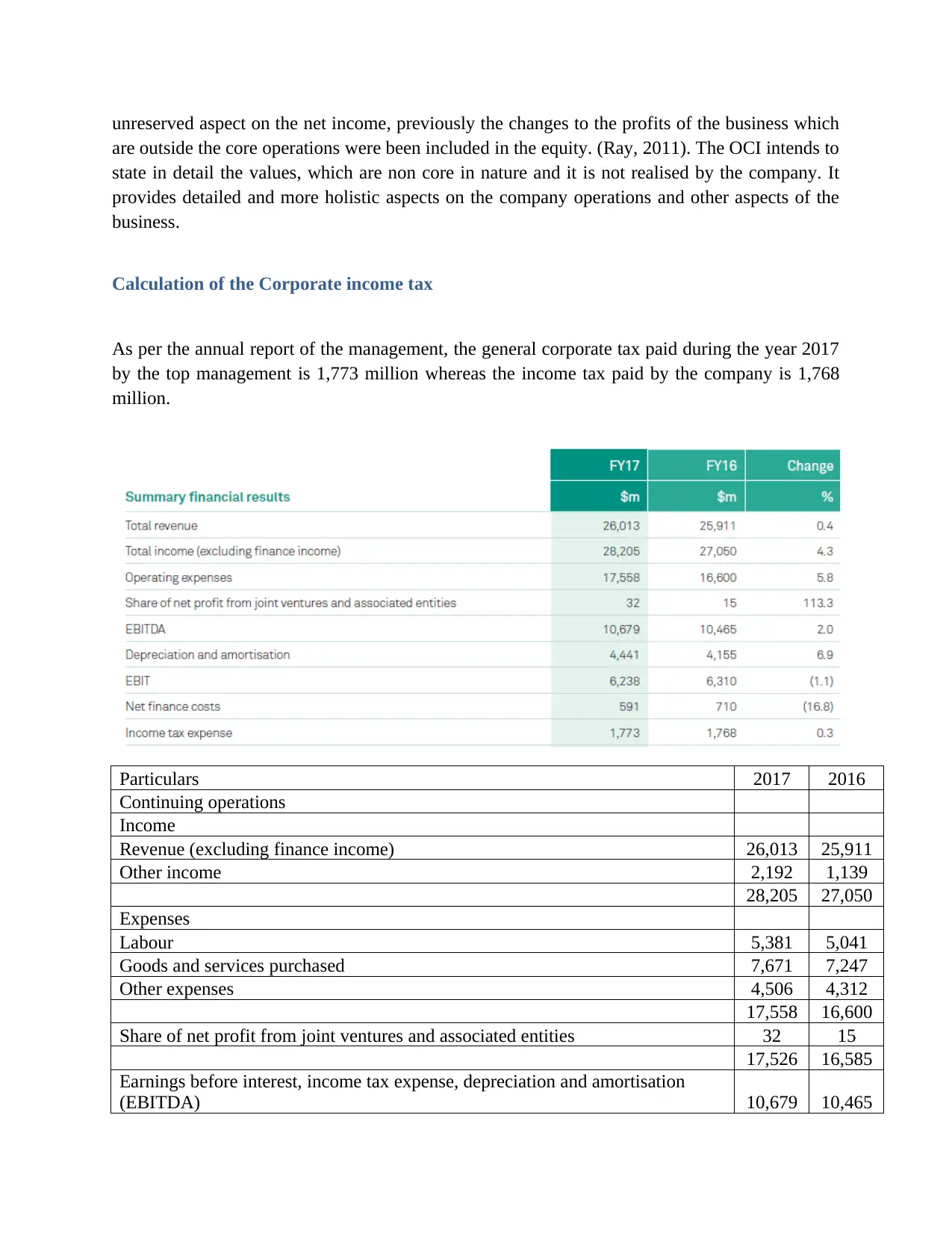
unreserved aspect on the net income, previously the changes to the profits of the business which
are outside the core operations were been included in the equity. (Ray, 2011). The OCI intends to
state in detail the values, which are non core in nature and it is not realised by the company. It
provides detailed and more holistic aspects on the company operations and other aspects of the
business.
Calculation of the Corporate income tax
As per the annual report of the management, the general corporate tax paid during the year 2017
by the top management is 1,773 million whereas the income tax paid by the company is 1,768
million.
Particulars 2017 2016
Continuing operations
Income
Revenue (excluding finance income) 26,013 25,911
Other income 2,192 1,139
28,205 27,050
Expenses
Labour 5,381 5,041
Goods and services purchased 7,671 7,247
Other expenses 4,506 4,312
17,558 16,600
Share of net profit from joint ventures and associated entities 32 15
17,526 16,585
Earnings before interest, income tax expense, depreciation and amortisation
(EBITDA) 10,679 10,465
are outside the core operations were been included in the equity. (Ray, 2011). The OCI intends to
state in detail the values, which are non core in nature and it is not realised by the company. It
provides detailed and more holistic aspects on the company operations and other aspects of the
business.
Calculation of the Corporate income tax
As per the annual report of the management, the general corporate tax paid during the year 2017
by the top management is 1,773 million whereas the income tax paid by the company is 1,768
million.
Particulars 2017 2016
Continuing operations
Income
Revenue (excluding finance income) 26,013 25,911
Other income 2,192 1,139
28,205 27,050
Expenses
Labour 5,381 5,041
Goods and services purchased 7,671 7,247
Other expenses 4,506 4,312
17,558 16,600
Share of net profit from joint ventures and associated entities 32 15
17,526 16,585
Earnings before interest, income tax expense, depreciation and amortisation
(EBITDA) 10,679 10,465
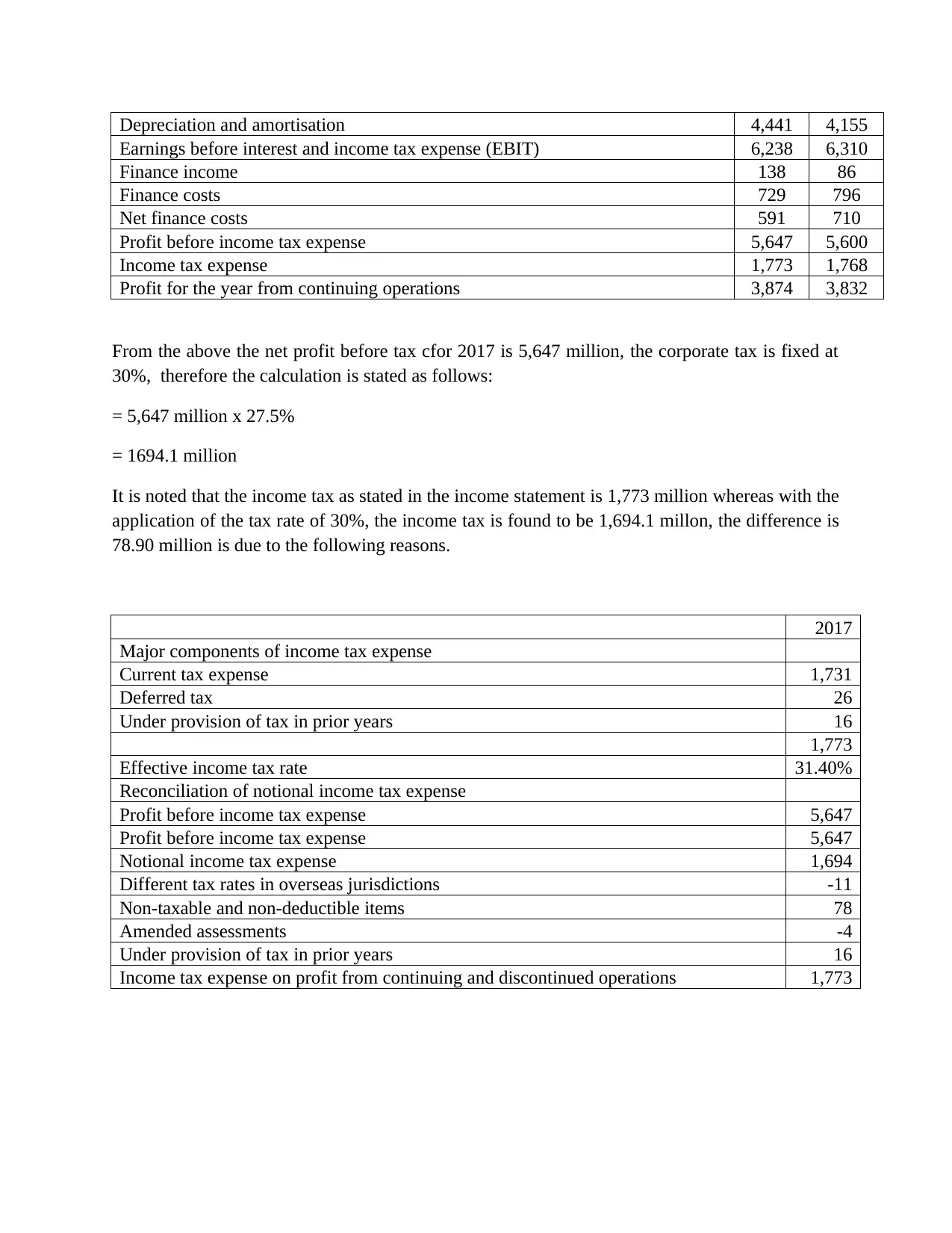
Depreciation and amortisation 4,441 4,155
Earnings before interest and income tax expense (EBIT) 6,238 6,310
Finance income 138 86
Finance costs 729 796
Net finance costs 591 710
Profit before income tax expense 5,647 5,600
Income tax expense 1,773 1,768
Profit for the year from continuing operations 3,874 3,832
From the above the net profit before tax cfor 2017 is 5,647 million, the corporate tax is fixed at
30%, therefore the calculation is stated as follows:
= 5,647 million x 27.5%
= 1694.1 million
It is noted that the income tax as stated in the income statement is 1,773 million whereas with the
application of the tax rate of 30%, the income tax is found to be 1,694.1 millon, the difference is
78.90 million is due to the following reasons.
2017
Major components of income tax expense
Current tax expense 1,731
Deferred tax 26
Under provision of tax in prior years 16
1,773
Effective income tax rate 31.40%
Reconciliation of notional income tax expense
Profit before income tax expense 5,647
Profit before income tax expense 5,647
Notional income tax expense 1,694
Different tax rates in overseas jurisdictions -11
Non-taxable and non-deductible items 78
Amended assessments -4
Under provision of tax in prior years 16
Income tax expense on profit from continuing and discontinued operations 1,773
Earnings before interest and income tax expense (EBIT) 6,238 6,310
Finance income 138 86
Finance costs 729 796
Net finance costs 591 710
Profit before income tax expense 5,647 5,600
Income tax expense 1,773 1,768
Profit for the year from continuing operations 3,874 3,832
From the above the net profit before tax cfor 2017 is 5,647 million, the corporate tax is fixed at
30%, therefore the calculation is stated as follows:
= 5,647 million x 27.5%
= 1694.1 million
It is noted that the income tax as stated in the income statement is 1,773 million whereas with the
application of the tax rate of 30%, the income tax is found to be 1,694.1 millon, the difference is
78.90 million is due to the following reasons.
2017
Major components of income tax expense
Current tax expense 1,731
Deferred tax 26
Under provision of tax in prior years 16
1,773
Effective income tax rate 31.40%
Reconciliation of notional income tax expense
Profit before income tax expense 5,647
Profit before income tax expense 5,647
Notional income tax expense 1,694
Different tax rates in overseas jurisdictions -11
Non-taxable and non-deductible items 78
Amended assessments -4
Under provision of tax in prior years 16
Income tax expense on profit from continuing and discontinued operations 1,773
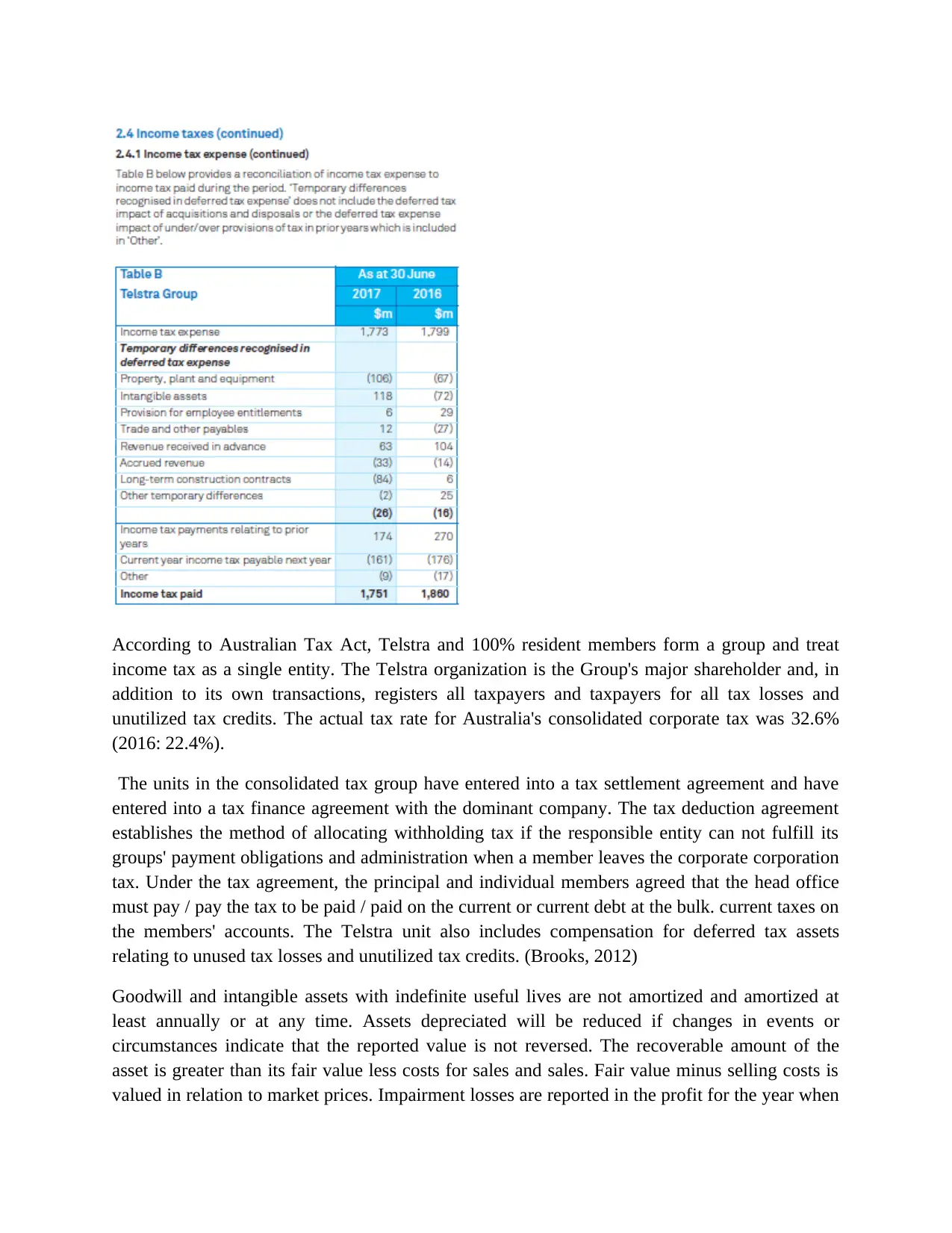
According to Australian Tax Act, Telstra and 100% resident members form a group and treat
income tax as a single entity. The Telstra organization is the Group's major shareholder and, in
addition to its own transactions, registers all taxpayers and taxpayers for all tax losses and
unutilized tax credits. The actual tax rate for Australia's consolidated corporate tax was 32.6%
(2016: 22.4%).
The units in the consolidated tax group have entered into a tax settlement agreement and have
entered into a tax finance agreement with the dominant company. The tax deduction agreement
establishes the method of allocating withholding tax if the responsible entity can not fulfill its
groups' payment obligations and administration when a member leaves the corporate corporation
tax. Under the tax agreement, the principal and individual members agreed that the head office
must pay / pay the tax to be paid / paid on the current or current debt at the bulk. current taxes on
the members' accounts. The Telstra unit also includes compensation for deferred tax assets
relating to unused tax losses and unutilized tax credits. (Brooks, 2012)
Goodwill and intangible assets with indefinite useful lives are not amortized and amortized at
least annually or at any time. Assets depreciated will be reduced if changes in events or
circumstances indicate that the reported value is not reversed. The recoverable amount of the
asset is greater than its fair value less costs for sales and sales. Fair value minus selling costs is
valued in relation to market prices. Impairment losses are reported in the profit for the year when
income tax as a single entity. The Telstra organization is the Group's major shareholder and, in
addition to its own transactions, registers all taxpayers and taxpayers for all tax losses and
unutilized tax credits. The actual tax rate for Australia's consolidated corporate tax was 32.6%
(2016: 22.4%).
The units in the consolidated tax group have entered into a tax settlement agreement and have
entered into a tax finance agreement with the dominant company. The tax deduction agreement
establishes the method of allocating withholding tax if the responsible entity can not fulfill its
groups' payment obligations and administration when a member leaves the corporate corporation
tax. Under the tax agreement, the principal and individual members agreed that the head office
must pay / pay the tax to be paid / paid on the current or current debt at the bulk. current taxes on
the members' accounts. The Telstra unit also includes compensation for deferred tax assets
relating to unused tax losses and unutilized tax credits. (Brooks, 2012)
Goodwill and intangible assets with indefinite useful lives are not amortized and amortized at
least annually or at any time. Assets depreciated will be reduced if changes in events or
circumstances indicate that the reported value is not reversed. The recoverable amount of the
asset is greater than its fair value less costs for sales and sales. Fair value minus selling costs is
valued in relation to market prices. Impairment losses are reported in the profit for the year when
Secure Best Marks with AI Grader
Need help grading? Try our AI Grader for instant feedback on your assignments.
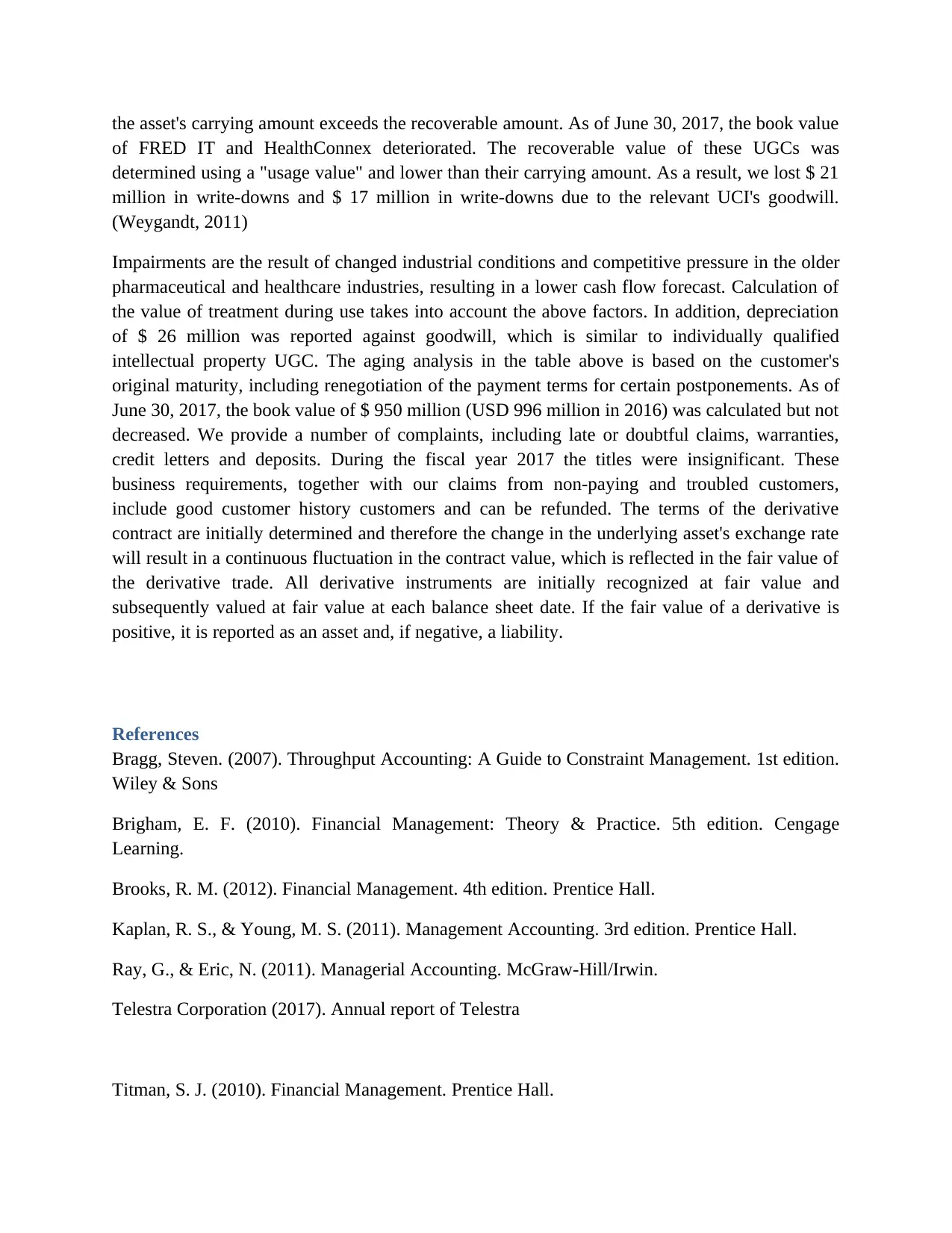
the asset's carrying amount exceeds the recoverable amount. As of June 30, 2017, the book value
of FRED IT and HealthConnex deteriorated. The recoverable value of these UGCs was
determined using a "usage value" and lower than their carrying amount. As a result, we lost $ 21
million in write-downs and $ 17 million in write-downs due to the relevant UCI's goodwill.
(Weygandt, 2011)
Impairments are the result of changed industrial conditions and competitive pressure in the older
pharmaceutical and healthcare industries, resulting in a lower cash flow forecast. Calculation of
the value of treatment during use takes into account the above factors. In addition, depreciation
of $ 26 million was reported against goodwill, which is similar to individually qualified
intellectual property UGC. The aging analysis in the table above is based on the customer's
original maturity, including renegotiation of the payment terms for certain postponements. As of
June 30, 2017, the book value of $ 950 million (USD 996 million in 2016) was calculated but not
decreased. We provide a number of complaints, including late or doubtful claims, warranties,
credit letters and deposits. During the fiscal year 2017 the titles were insignificant. These
business requirements, together with our claims from non-paying and troubled customers,
include good customer history customers and can be refunded. The terms of the derivative
contract are initially determined and therefore the change in the underlying asset's exchange rate
will result in a continuous fluctuation in the contract value, which is reflected in the fair value of
the derivative trade. All derivative instruments are initially recognized at fair value and
subsequently valued at fair value at each balance sheet date. If the fair value of a derivative is
positive, it is reported as an asset and, if negative, a liability.
References
Bragg, Steven. (2007). Throughput Accounting: A Guide to Constraint Management. 1st edition.
Wiley & Sons
Brigham, E. F. (2010). Financial Management: Theory & Practice. 5th edition. Cengage
Learning.
Brooks, R. M. (2012). Financial Management. 4th edition. Prentice Hall.
Kaplan, R. S., & Young, M. S. (2011). Management Accounting. 3rd edition. Prentice Hall.
Ray, G., & Eric, N. (2011). Managerial Accounting. McGraw-Hill/Irwin.
Telestra Corporation (2017). Annual report of Telestra
Titman, S. J. (2010). Financial Management. Prentice Hall.
of FRED IT and HealthConnex deteriorated. The recoverable value of these UGCs was
determined using a "usage value" and lower than their carrying amount. As a result, we lost $ 21
million in write-downs and $ 17 million in write-downs due to the relevant UCI's goodwill.
(Weygandt, 2011)
Impairments are the result of changed industrial conditions and competitive pressure in the older
pharmaceutical and healthcare industries, resulting in a lower cash flow forecast. Calculation of
the value of treatment during use takes into account the above factors. In addition, depreciation
of $ 26 million was reported against goodwill, which is similar to individually qualified
intellectual property UGC. The aging analysis in the table above is based on the customer's
original maturity, including renegotiation of the payment terms for certain postponements. As of
June 30, 2017, the book value of $ 950 million (USD 996 million in 2016) was calculated but not
decreased. We provide a number of complaints, including late or doubtful claims, warranties,
credit letters and deposits. During the fiscal year 2017 the titles were insignificant. These
business requirements, together with our claims from non-paying and troubled customers,
include good customer history customers and can be refunded. The terms of the derivative
contract are initially determined and therefore the change in the underlying asset's exchange rate
will result in a continuous fluctuation in the contract value, which is reflected in the fair value of
the derivative trade. All derivative instruments are initially recognized at fair value and
subsequently valued at fair value at each balance sheet date. If the fair value of a derivative is
positive, it is reported as an asset and, if negative, a liability.
References
Bragg, Steven. (2007). Throughput Accounting: A Guide to Constraint Management. 1st edition.
Wiley & Sons
Brigham, E. F. (2010). Financial Management: Theory & Practice. 5th edition. Cengage
Learning.
Brooks, R. M. (2012). Financial Management. 4th edition. Prentice Hall.
Kaplan, R. S., & Young, M. S. (2011). Management Accounting. 3rd edition. Prentice Hall.
Ray, G., & Eric, N. (2011). Managerial Accounting. McGraw-Hill/Irwin.
Telestra Corporation (2017). Annual report of Telestra
Titman, S. J. (2010). Financial Management. Prentice Hall.

Weygandt. (2011). Managerial Accounting: Tools for Business Decision Making (6th ed.).
Wiley.
Wiley.
1 out of 12
Your All-in-One AI-Powered Toolkit for Academic Success.
+13062052269
info@desklib.com
Available 24*7 on WhatsApp / Email
![[object Object]](/_next/static/media/star-bottom.7253800d.svg)
Unlock your academic potential
© 2024 | Zucol Services PVT LTD | All rights reserved.





